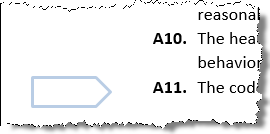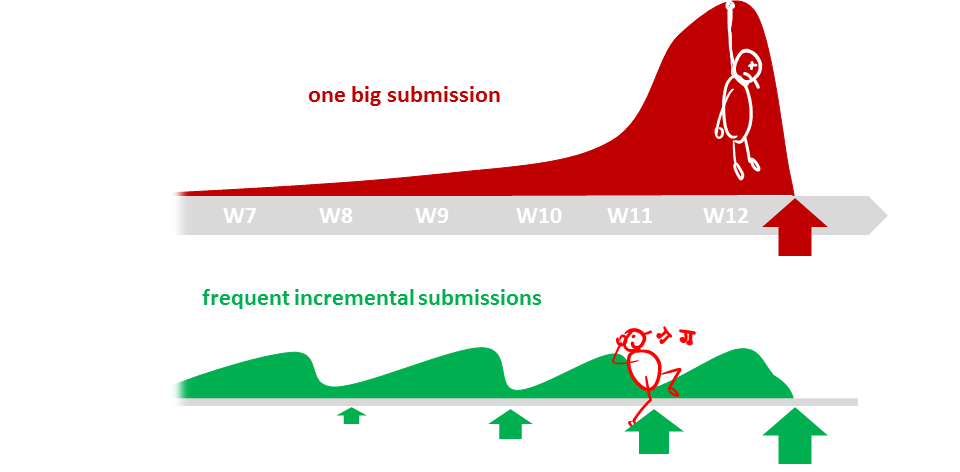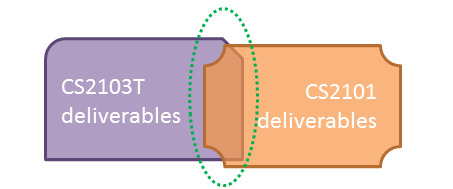Individual Project (iP):
Team Project (tP):
Week 6 [Sep 16] - Admin Info
- Submit post-lecture quiz
- [optional] Submit mid-term feedback for the teaching team by Sunday
1 Submit post-lecture quiz
- As per usual.
2 [optional] Submit mid-term feedback for the teaching team by Sunday
- An anonymous survey to submit feedback about the teaching team will open on LumiNUS around Monday. You will receive an email when it opens. Please take a few minutes to give feedback to your tutors.
+ Other admin info you may want to read this week:
There is no midterm.
The final exam has two parts:
- Part 1: MCQ questions (1 hour, 20 marks)
- Part 2: Essay questions (1 hour, 20 marks)
Both papers will be given to you at the start but you need to answer Part 1 first (i.e. MCQ paper). It will be collected 1 hour after the exam start time (even if arrived late for the exam). You are free to start part 2 early if you finish Part 1 early.
Given the fast pace required by the paper, the large class size, and the need to collect part 1 answer scripts in the middle of the exam, to be fair to all students, invigilators will not answer queries about the questions in the exam paper (but will answer queries related to exam administration).
- If you have a doubt/query about a question ,or would like to make an assumption about a question, or would like to report a potential error in the exam paper, write down your doubt/query/assumption in the space provided for it at the end of the exam paper.
- Those doubts/queries/assumptions (if justified) will be taken into account when grading.
Final Exam: Part 1 (MCQ)
Each MCQ question gives you a statement to evaluate.
An example statement
Testing is a Q&A activity
Unless stated otherwise, the meaning of answer options are
A: Agree. If the question has multiple statements, agree with all of them.
B: Disagree. If the question has multiple statements, disagree with at least one of them
C, D, E: Not used
Number of questions: 100
Note that you have slightly more than ½ minute for each question, which means you need to go through the questions fairly quickly.
Questions in Part 1 are confidential. You are not allowed to reveal Part 1 content to anyone after the exam. All pages of the exam paper are to be returned at the end of the exam.
You will be given OCR forms (i.e., bubble sheets) to indicate your answers for Part 1. As each OCR form can accommodate only 50 answers, you will be given 2 OCR forms. Indicate your student number in both OCR forms.
To save space, we use the following notation in MCQ question. [x | y | z] means ‘x and z, but not y’
SE is [boring | useful | fun] means SE is not boring AND SE is useful AND SE is fun.
Consider the following statement:
- IDEs can help with [writing | debugging | testing] code.
The correct response for it is Disagree because IDEs can help with all three of the given options, not just writing and testing.
Some questions will use highlighting to draw your attention to a specific part of the question. That is because those parts are highly relevant to the answer and we don’t want you to miss the relevance of that part.
Consider the statement below:
Technique ABC can be used to generate more test cases.
The word can is highlighted because the decision you need to make is whether the ABC can or cannot be used to generate more test cases; the decision is not whether ABC can be used to generate more or better test cases.
Markers such as the one given below appears at left margin of the paper to indicate where the question corresponds to a new column in the OCR form. E.g. questions 11, 21, 31, etc. (a column has 10 questions). Such markers can help you to detect if you missed a question in the previous 10 questions. You can safely ignore those markers if you are not interested in making use of that additional hint.

Some questions have tags e.g., the question below has a tag JAVA. These tags provide additional context about the question. In the example below, the tag indicates that the code given in the
question is Java code.

The exam paper is open-book: you may bring any printed or written materials to the exam in hard copy format. However, given the fast pace required by Part 1, you will not have time left to refer notes during that part of the exam.
Mark the OCR form as you go, rather than planning to transfer your answers to the OCR form near the end. Reason: Given there are 100 questions, it will be hard to estimate how much time you need to mass-transfer all answers to OCR forms.
Write the answer in the exam paper as well when marking it in the OCR form. Reason: It will reduce the chance of missing a question. Furthermore, in case you missed a question, it will help you correct the OCR form quickly.
We have tried to avoid deliberately misleading/tricky questions. If a question seems to take a very long time to figure out, you are probably over-thinking it.
You will be given a practice exam paper to familiarize yourself with this slightly unusual exam format.
Final Exam: Part 2 (Essay)
Yes, you may use pencils when answering part 2.
If your team is facing difficulties due to differences in skill/motivation /availability among team members,
-
First, do not expect everyone to have the same skill/motivation level as you. It is fine if someone wants to do less and have low expectations from the module. That doesn't mean that person is a bad person. Everyone is entitled to have their own priorities.
-
Second, don't give up. It is unfortunate that your team ended up in this situation, but you can turn it into a good learning opportunity. You don't get an opportunity to save a sinking team every day 😃
-
Third, if you care about your grade and willing to work for it, you need to take initiative to turn the situation around or else the whole team is going to suffer. Don't hesitate to take charge if the situation calls for it. By doing so, you'll be doing a favor for your team. Be professional, kind, and courteous to the team members, but also be firm and assertive. It is your grade that is at stake. Don't worry about making a bad situation worse. You won't know until you try.
-
Finally, don't feel angry or 'wronged'. Teamwork problems are not uncommon in this module and we know how to grade so that you will not be penalized for others' low contribution. We can use Git to find exactly what others did. It's not your responsibility to get others to contribute.
Given below are some suggestions you can adopt if the project work is not going smooth due to team issues. Note that the below measures can result in some team members doing more work than others and earning better project grades than others. It is still better than sinking the whole team together.
-
Redistribute the work: Stronger programmers in the team should take over the critical parts of the code.
-
Enforce stricter integration workflow: Appoint an integrator (typically, the strongest programmer). His/her job is to maintain the integrated version of the code. He/she should not accept any code that breaks the existing product or is not up to the acceptable quality standard. It is up to others to submit acceptable code to the integrator. Note that if the integrator rejected your code unreasonably, you can still earn marks for that code. You are allowed to submit such 'rejected' code for grading. They can earn marks based on the quality of the code.
If you have very unreliable or totally disengaged team members :
- Re-allocate to others any mission-critical work allocated to that person so that such team members cannot bring down the entire team.
- However, do not leave out such team members from project communications. Always keep them in the loop so that they can contribute any time they wish to.
- Furthermore, evaluate them sincerely and fairly during peer evaluations so that they do get the grade their work deserves, no more, no less.
- Be courteous to such team members too. Some folks have genuine problems that prevent them from contributing more although they may not be able tell you the reasons. Just do your best for the project and assume everyone else is doing their best too, although their best may be lower than yours.
Why so many submissions?

The high number of submissions is not meant to increase workload but to spread it across the semester. Learning theory and applying them should be done in parallel to maximize the learning effect. That can happen only if we spread theory and 'application of theory' (i.e., project work) evenly across the semester.
Why submission requirements differ between CS2103/T and CS2101?

They do, and they should.
CS2103T communication requirements are limited to a very narrow scope (i.e., communicate about the product to users and developers). CS2101 aims to teach you technical communication in a much wider context. While you may be able to reuse some of the stuff across the two modules, submissions are not intended to be exactly the same.